The term Shakti has a variety of meanings in India. According to the Samsad Bengali-English Dictionary, it means power, strength, might, force, capability, energy & potency. Shakti also means the female principle taking part in creation, or the female deity. People of Bengal have always been community followers of Shaktism (the Shakti cult). There are a number of festivals dedicated to the worship of the Goddess.
The Autumn season in Bengal is happy times for the people living here, as it is filled with one festival after the other. Durga Puja is the first of the lot. Durga Puja is followed by Lakshmi Puja; Lakshmi Puja is followed by Kali Puja; Kali Pujais followed by Jagadhatri Puja. And it is about Jagadhatri Puja that we’re going to discuss in this post.
The name Jagadhatri came from a title given to Durga in the Devi Mahatmya, after she killed the demon Mahishasura. The gods sang her praises and worshiped her with divine flowers, and she was called the sustainer (dhatri) of the universe (jagat), thus Jagadhatri.
If you go searching for Jagadhatri idols in Kolkata, there might be very few that would turn up. The two cities of Bengal, really famous for the worship of this goddess, is Krishnanagar (Nadia District) and Chandannagar (Former French colony, Hoogly District). Though, nowadays, Chandannagar displays much more opulence during this Puja, Krishnanagar, apart from being my ancestral town, has a special historical significance in the advent of Jagadhatri Puja. According to legend, Krishnachandra Ray, the raja of Krishnanagar of the Nadia District, was the one introduced the public worship of goddess Jagaddhatri.
Once, Raja Krishnachandra, was captured by Siraj, the then ruling emperor, for faulting taxes. When he was released from the prison, while returning by boat from Murshidabad to Nadia (this was at the time of the autumn Durga Puja), he heard the sound of the drums on the boat, signifying that it was the tenth or last day of the puja, and he, a devout follower of Durga, was depressed at missing the festivities.
Later that evening, he had a vision of the goddess Durga, appearing as a child, she told him to worship her in one month, on the ninth day of the bright fortnight in the month of Kartik, and also said that this would bring the same blessings from her. Later, while discussing this incident with the family priest, he was told that, this in fact was the goddess Jadadhatri. Krishnachandra ordered an artist to create a statue of the goddess Jagaddhatri, and he worshiped it with great splendor at the appointed time.
If one is to go by this legend, worship of Jagaddhatri was introduced during the middle of the eighteenth century. As the contemporary literature does not mention the puja however, it is likely that more public worship was begun later. The tradition, of worshipping Jagadhatri, is still followed in Krishnanagar Rajbari, with equal respite.
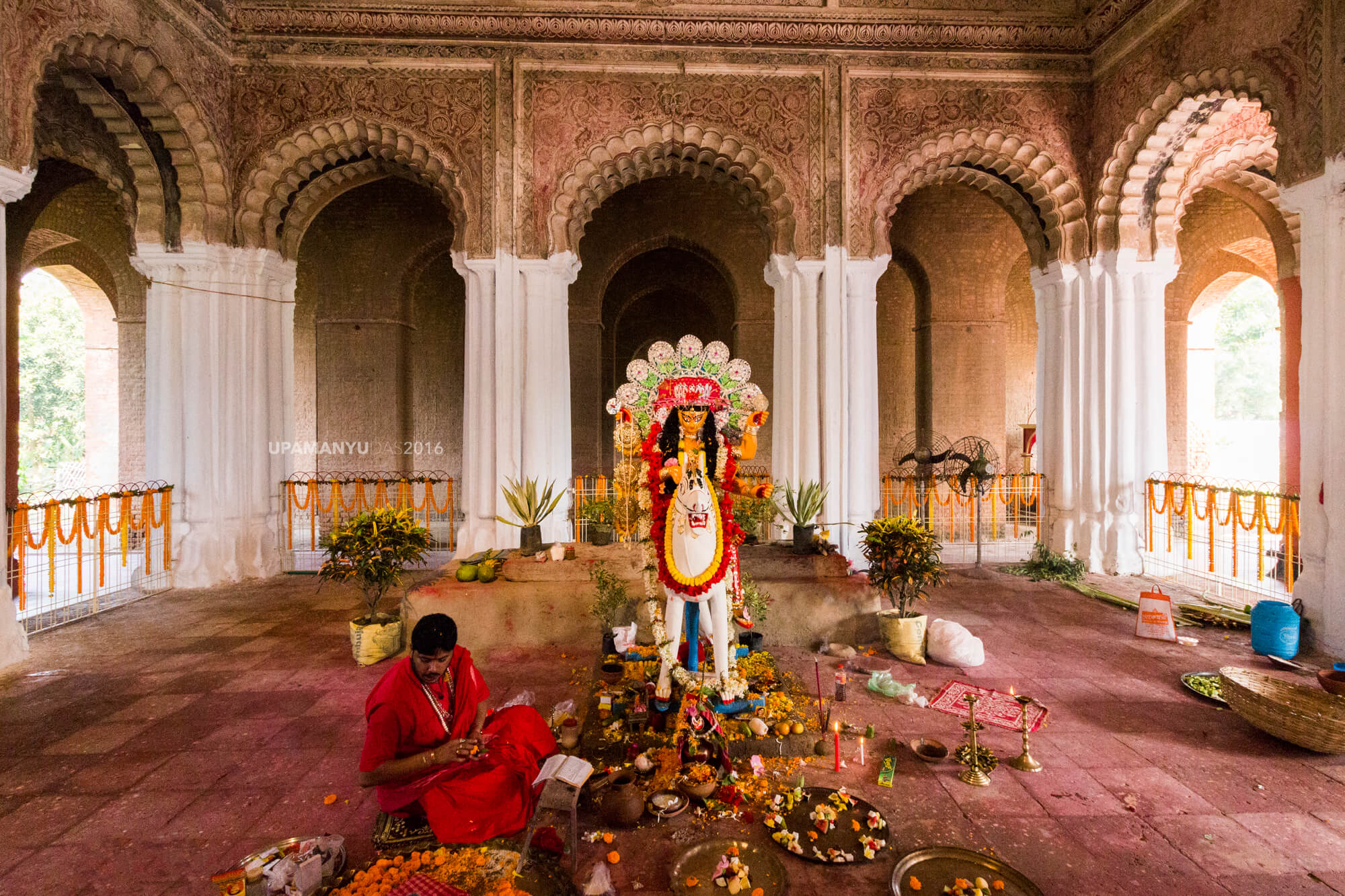
Along with the Rajbari, Jagadhatri Puja is celebrated all over Krishnanagar, but there is one more curious incident happening in the Malo-para locality of Krishnanagar. The word Malo means Fishermen in Bengali, and para meaning community, Malopara was the living area of the kings fishermen in those times. Along with being the official fishermen, having their obvious skills with water, they also used to help the king in immersing the goddess after the rituals.
So, one fine day, the community thinks, that we, being experts in immersing, why don’t we do our own puja of the goddess Jagadhatri! Thinking this, they went to their king, Raja Krishnachandra, and requested permission to perform their own puja. Although the king was sceptical, the kings wife relented, and gave them eleven rupees to start their own puja. Hence started the puja of Malopara. Even today, the puja does not start without the eleven rupees presented by the current queen! The fishermen, having limited space in their tightly woven community, started the puja in the temple of Jaleshwar or Shiva. Hence they named their goddess, Jaleshwari meaning wife of Shiva. Following is the photograph of Jaleshwari.
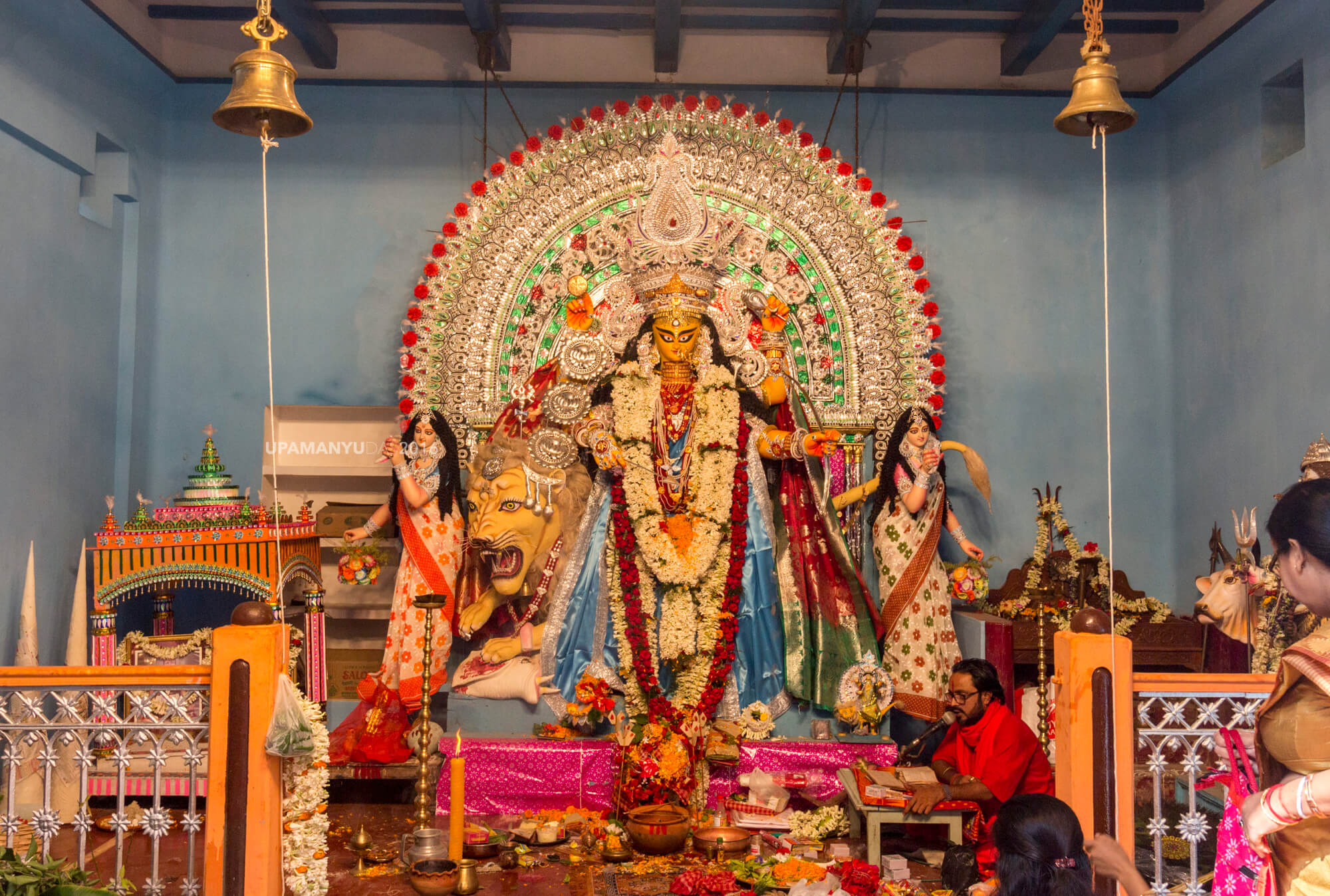
Here before the goddess Jaleshwari, dhuno (frankincense) pora is performed. The finely powdered frankincense is poured over a person which takes form of a magnificent flame and burns. Devotees take vows before the goddess. They fast the whole day, and just post noon, this event is held before the goddess to appease her, in an anticipation that she will grant the boon.
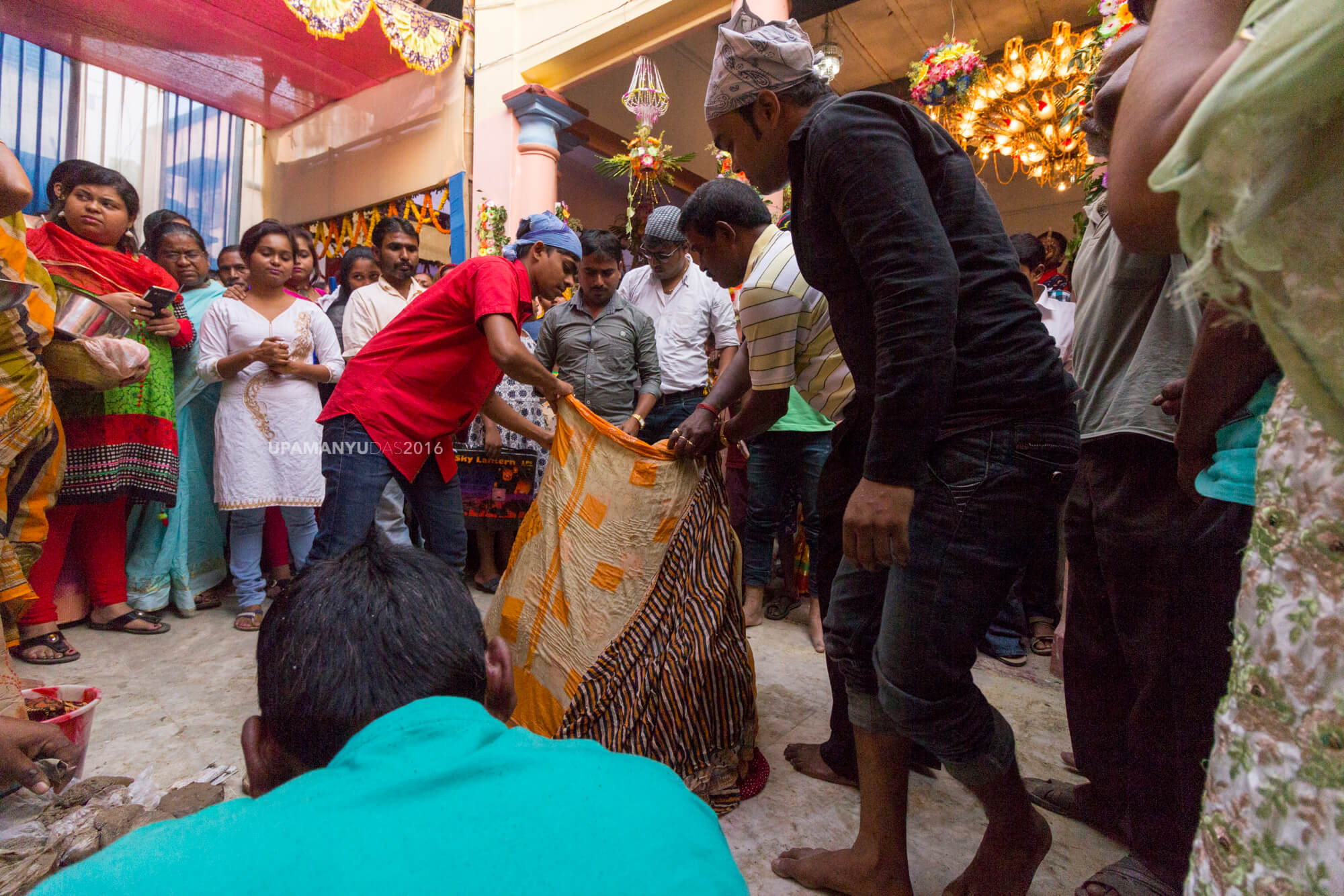
Before the show begins, the devotee is draped with wet saree, and lumps of wet mud is placed on both the hands and the head (see pictures).
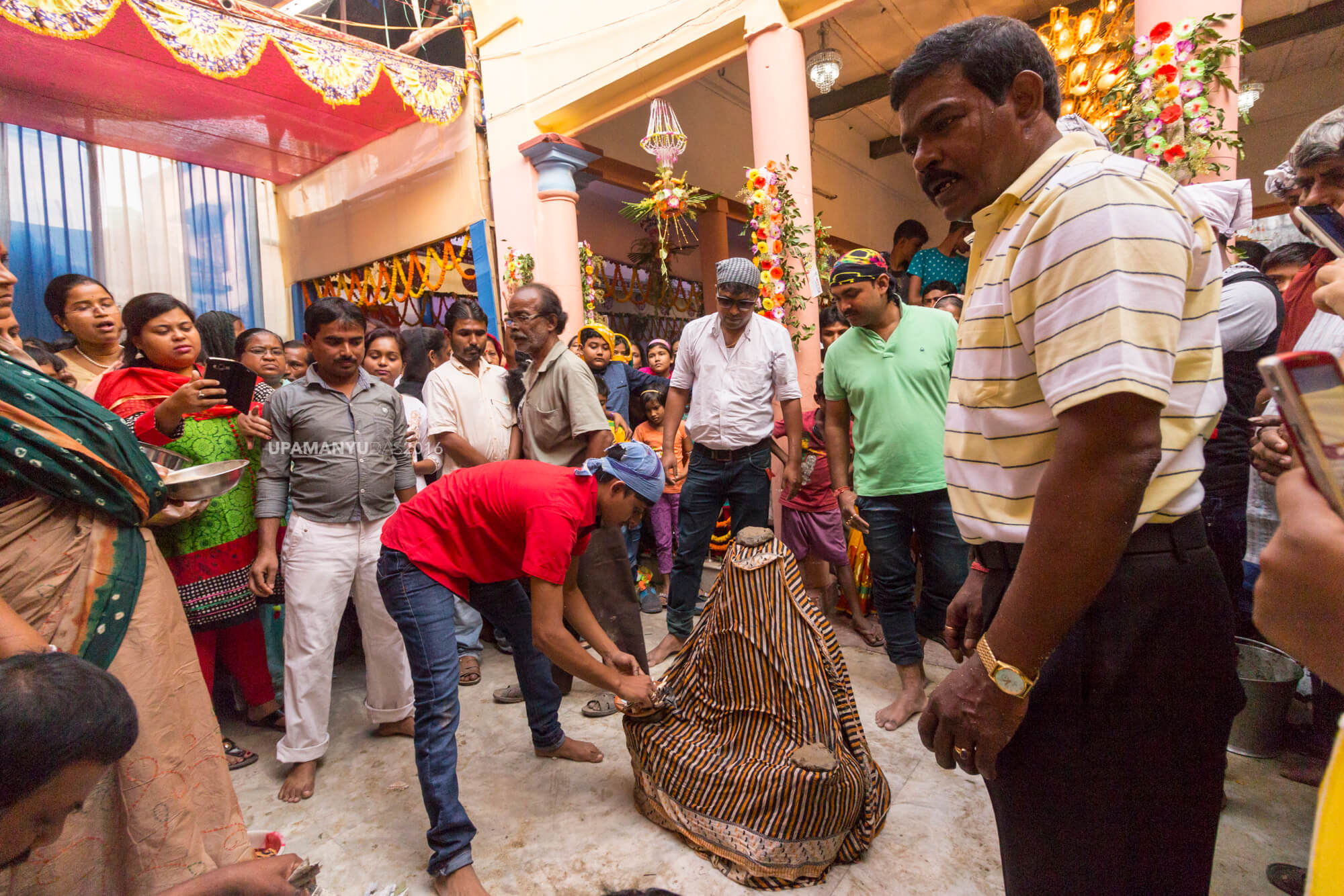
Finally, the fire is alighted and the show begins. (Find few more images of Dhuno Pora in my previous year’s post)
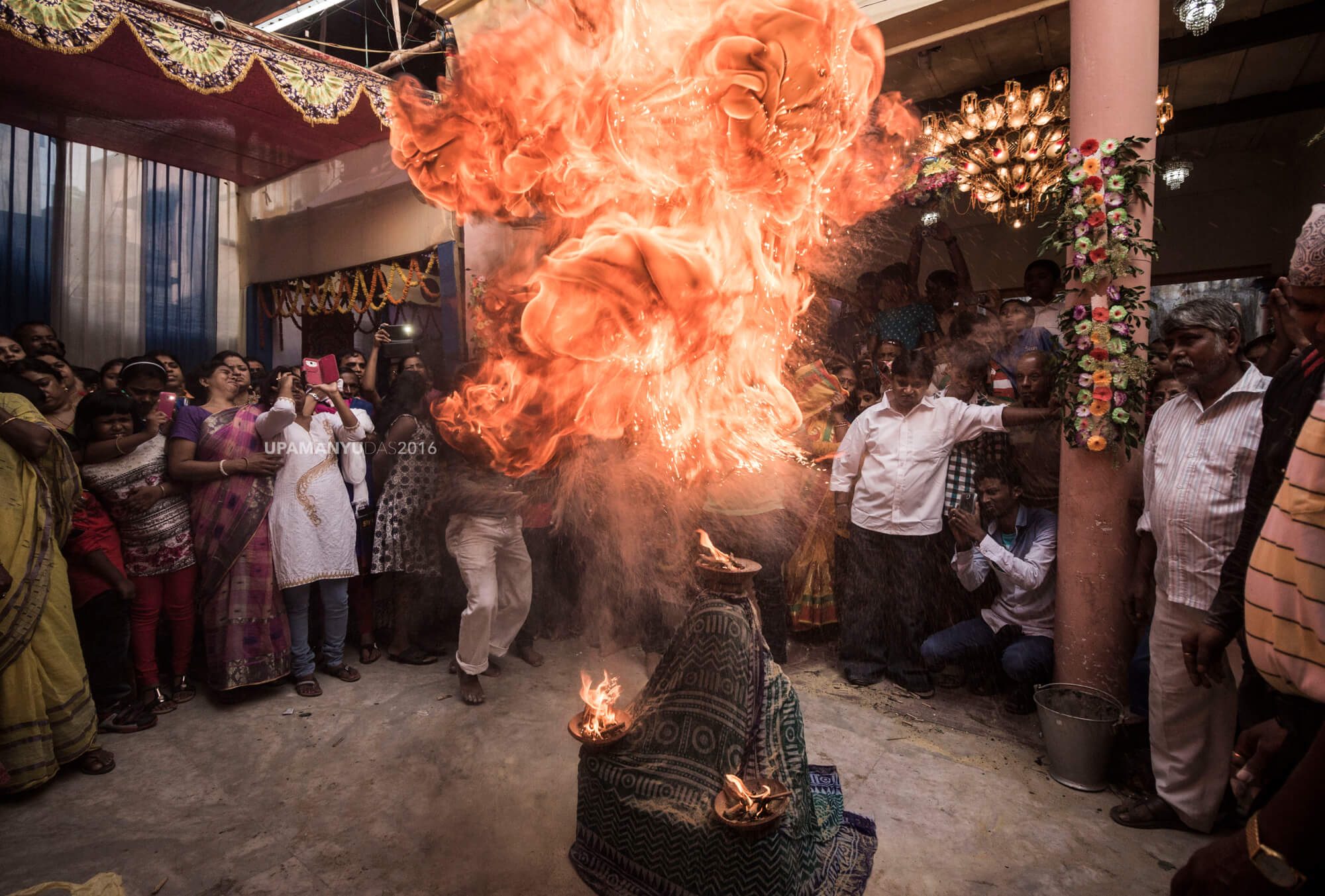
This is a dangerous task to perform, both for the person who is sitting and for the person who burns the dhuno as well for the person over whom the flames are burnt. Now, the origin of this curious tradition still remains unknown to me, but if thought carefully, seeing the affinity of the Hindu culture towards fire, this is not a thing of surprise.
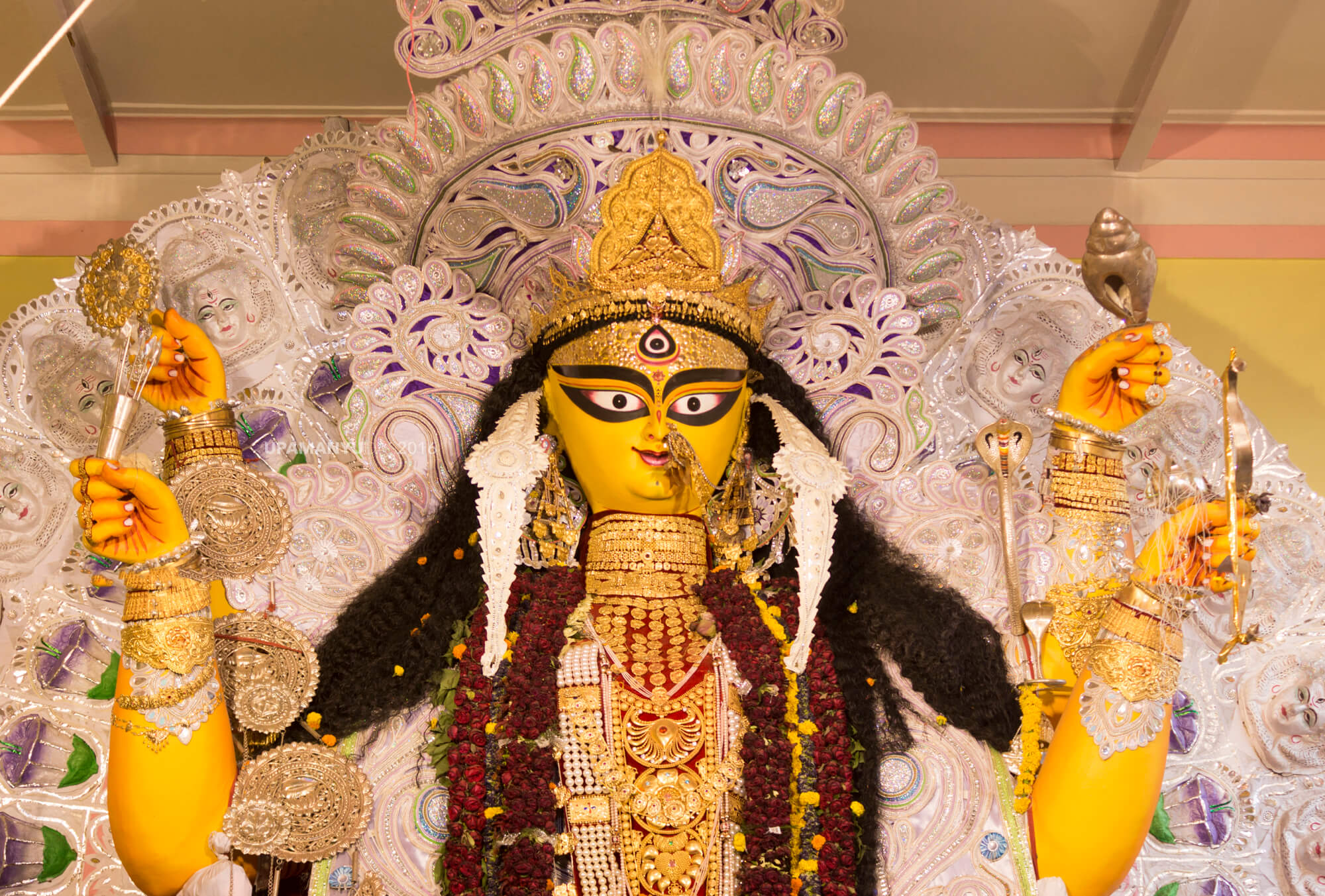
There is one more community of farmers, called the Chashapara. This is also a very talked about puja in the Krishnanagar locality. But this is pure hype. The goddess here wears more than 80kgs of gold each year. And more is being added to the coffers every year. The following image is the idol of Chashapara. All that shines here is in fact gold. The goddess is fondly called Burima by the locals, meaning the ancient one.
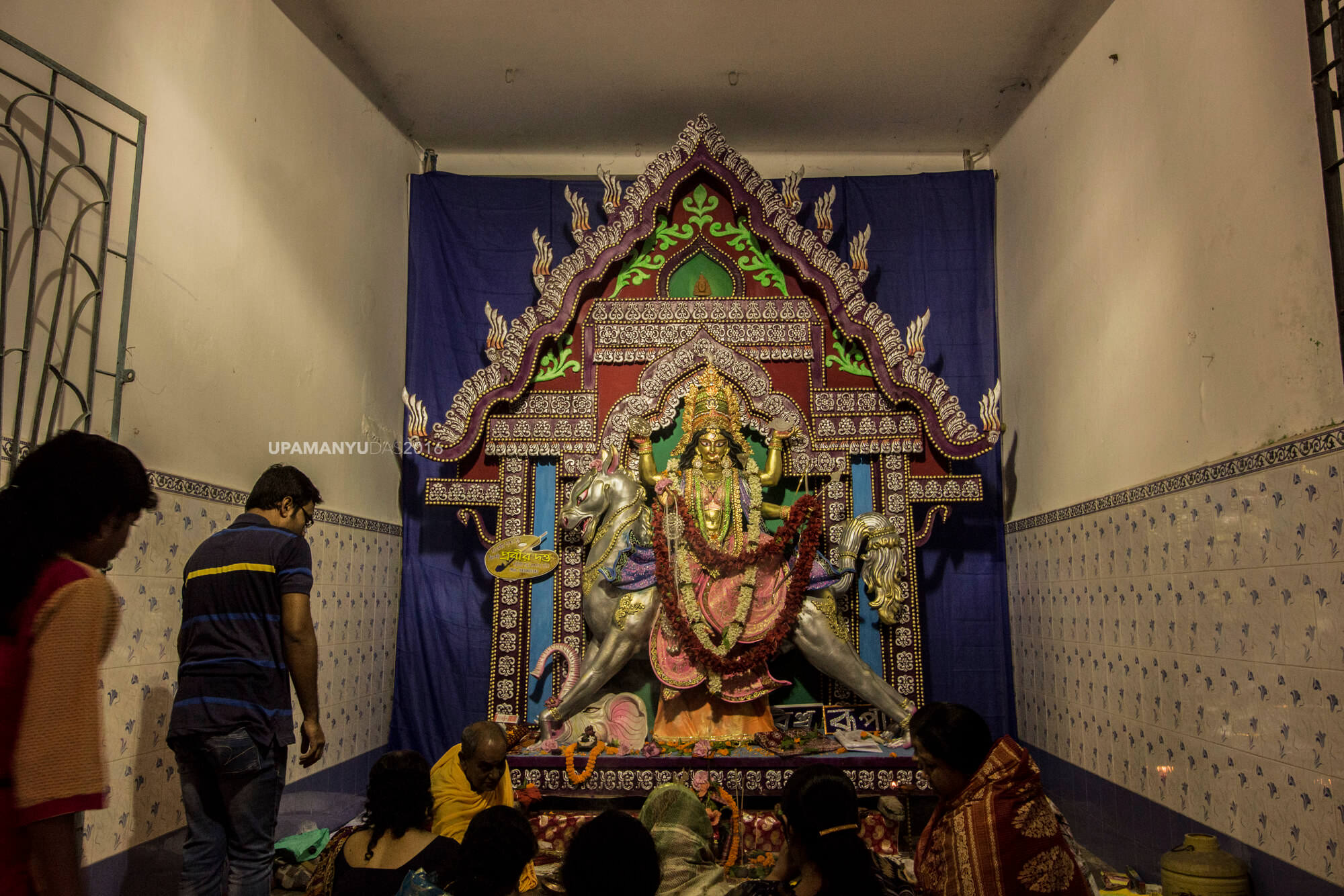
Another idol, named Viswarupa (the most beautiful), and in its small way breaking the prototypes of the traditional pujas, resides very close to my heart. This puja is performed by one of my relatives residing at my ancestral home in Krishnanagar.
There are many such other idols that are worshipped throughout Krishnanagar, that people from all over Bengal come to take the blessing from the goddess. The ritual lasts only one day, hence planning a short trip specifically for the Puja does not seem completely out of bounds, even in today’s fast and busy life.
While it is time for immersing the Goddess, just the next day she arrives, there are a fes spectacles awaiting the visitors at the Bhashan (immersion), spanning two days. According to the tradition, all idols are to line up for immersion at the ghats of the river Jalangi. Before immersing the idol, every idol has to make a detour of the King’s place, and once the King had seen the idols, only then can it be immersed.
All the paras (localities) start moving towards the Rajbari except one. There is another small story surrounding this exception in the rule. The name of the locality is Nederpara. Now, the people residing here, in the old days, were also big landlords. Although none were as big as the King, but since they were Zamindars in all respect, they decided to rebel against the King and show him disrespect by not paying the taxes, and not showing their idol to the King was just the extension to this rebellion. Pertaining to their attitude, the locality was named, না-দেওয়ার-পাড়া (the one who doesn’t pay taxes). This rebellion is still continued till date. Through time, the colloquial conversations has transformed the name Na-dewyar-para to Nederpara.
Coming back to the spectacle on the immersion day, the idols, after visiting the Kings palace, proceed towards the ghat on the road named High Street. Visitors and residents alike, line up in both the sides of the road and struggle to find places on the cemented areas in front of closed shops, to watch the spectacle, as idols arrive one by one throughout the night. Along with people, small street food joints also pop up along the street to meet the hunger pains of the crowd.
Now before I go for the interesting part, some general information about the way the idols are carried to the ghats. The immersions that happen on the first day, all the idols are placed over gridded stutters of Bamboo, and are carried by men. This is a tedious task to perform, and people from all over the locality come to help. All the fights between all the localities were carried out on the first day. In recent years, due to the strict rule by the police, has the fights decreased. The second day is more peaceful, the idols are carried on trucks, tempos or tractors depending upon the size of the idol.
Among the lot that goes for immersion, there is a few events that is worth mentioning. Like the gas lit lights of Malopara.
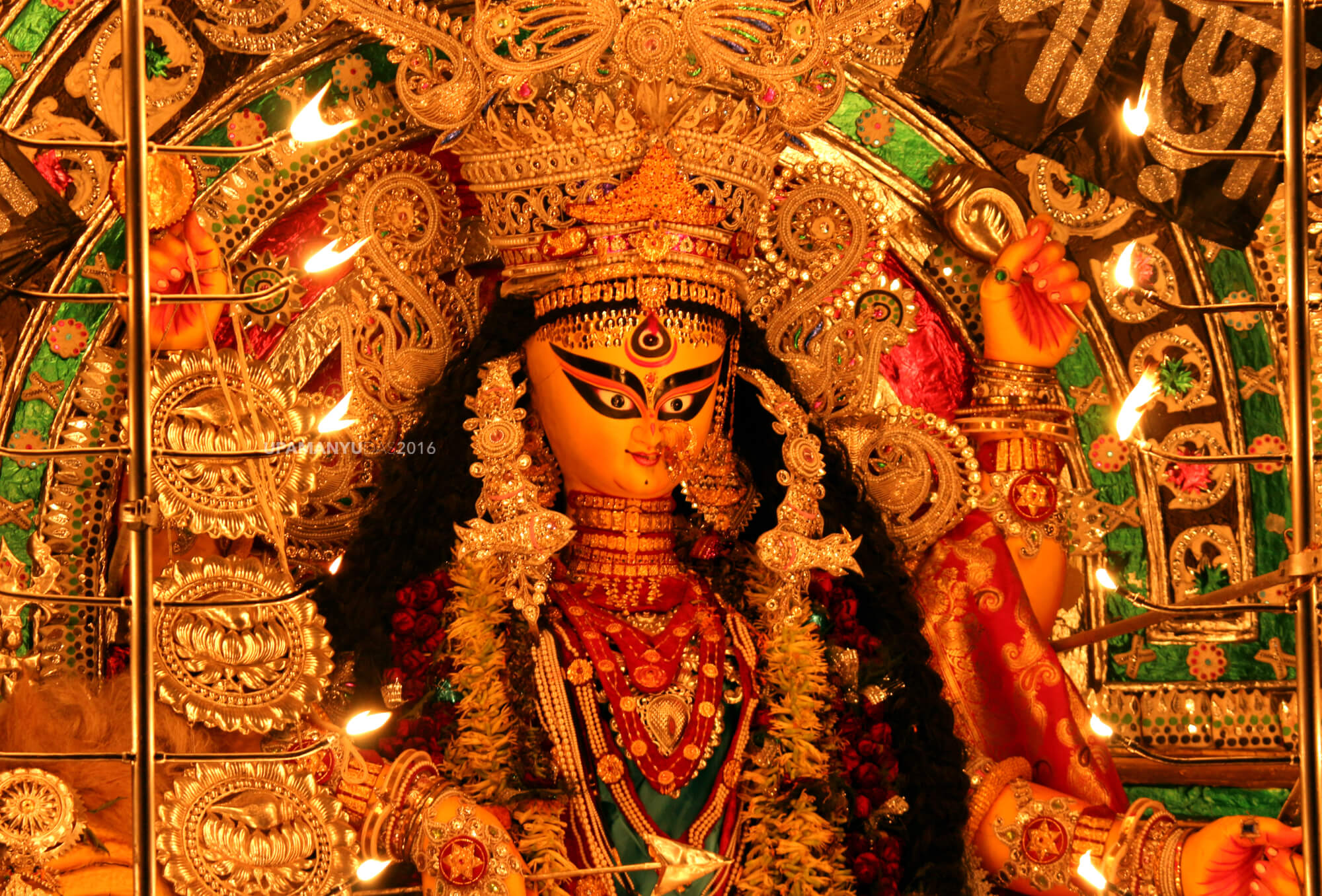
These lights, pioneered by Amulya Halder, in the mid 20th century, burns on calcium carbide, and the burners are British made. Before he revamped this burner system, the burners were erratic and the flames were not as beautiful. The flames burn with Calcium Carbide gas. Chunks of Calcium Carbide is place in a chamber surrounding water. The water is placed such that there is a small but steady flow, to react with CaC2 and produce acetylene gas. Before Halder pioneered, the gas flow was not appropriate, resulting in poorly lit flames. The first thing he did was to place two siphons instead of one, to ensure a steadier flow of gas. He reconstructed the copper pipes bringing the gas to the burner. He procured the British made burners from the Burrabazaar area of Calcutta. The result is worth watching.
Amongst other immersions of Day 1, there had been a debate since forever as to who will come last. Burima has won this debate since many years, and the idol almost comes at the break of dawn to the ghats. In the ghats, all the gold ornaments are taken down, which again takes almost two hours. Hundreds of people gather in the morning light, to see this spectacle (photograph below).
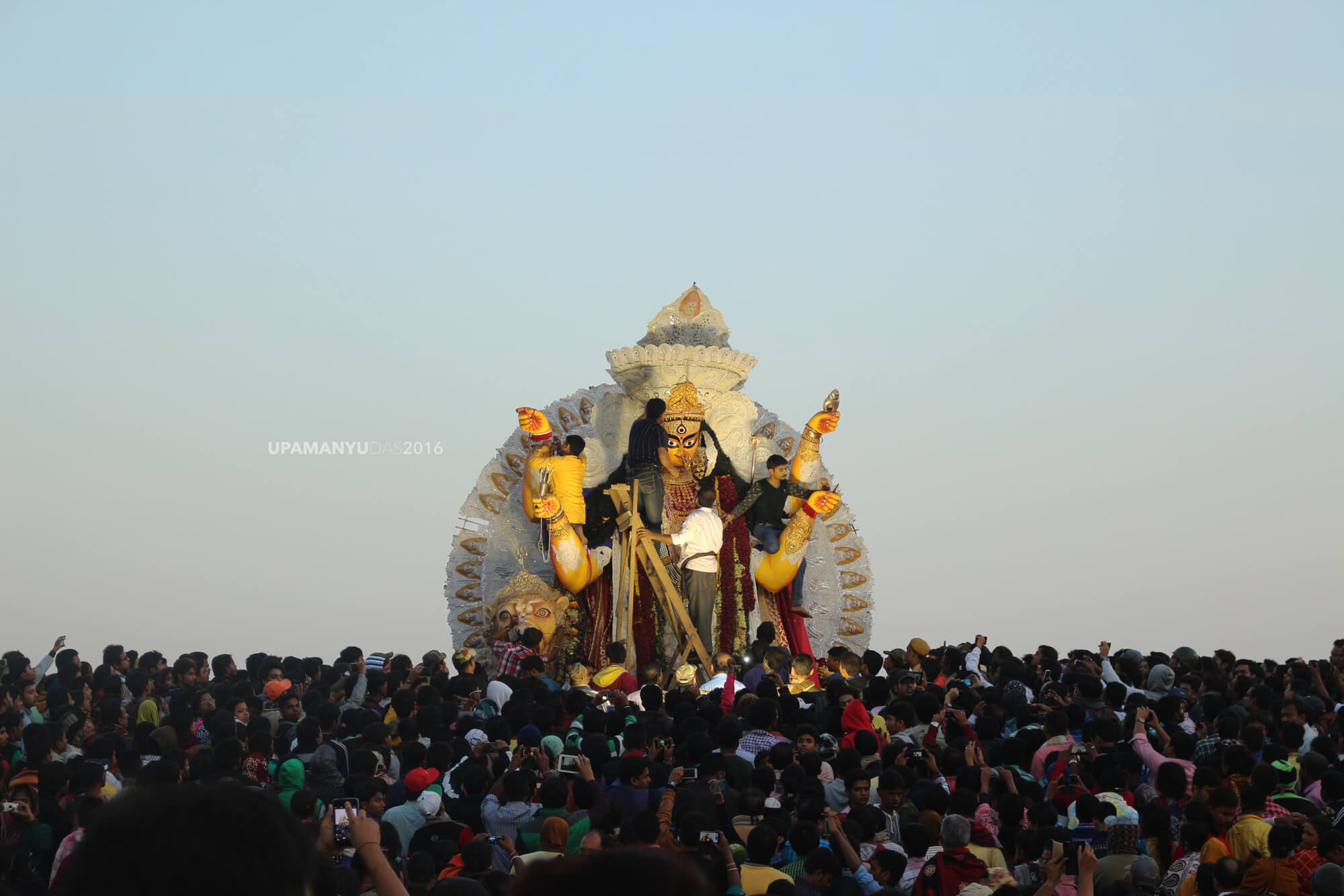
Now, one would easily wonder that how a started in Krishnanagar, went to Chandannagar which is almost 100 km apart. Now get an answer, one must again rely on legends. Legend has it that either a friend of Raja Krishnachandra or a Diwan of his court or both at different times, took his permission and started the worship of Jagadhatri in Chandannagar. And since then, it has slowly gained its popularity, even exceeding that of Krisnnagar in recent times.
There are many more myths and legends surrounding the worship of Shakti in various forms throughout Bengal. I have compiled all I’ve come to know from the residents of Krishnanagar and some references, in the post. I hope this helps put the Goddess worship in context.
May the Goddess Jagadhatri bless us.
P.S If anyone as any more information regarding any of the rituals mentioned here, please comment or get in touch with me at [email protected].
 Photography
Photography